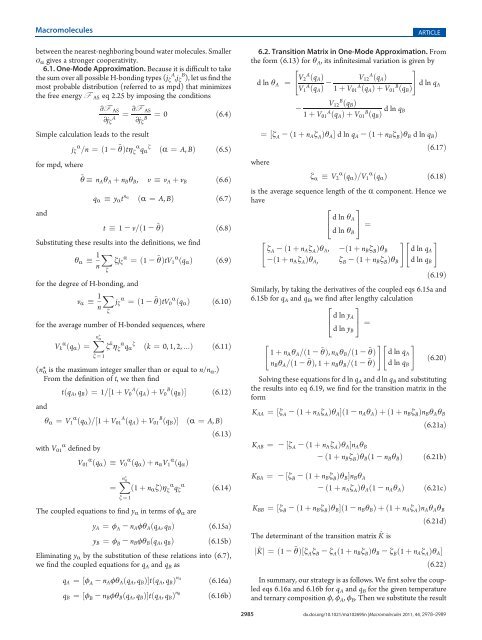Preferential Adsorption and Co-nonsolvency of ... - au one net
Preferential Adsorption and Co-nonsolvency of ... - au one net
Preferential Adsorption and Co-nonsolvency of ... - au one net
You also want an ePaper? Increase the reach of your titles
YUMPU automatically turns print PDFs into web optimized ePapers that Google loves.
Macromolecules ARTICLE<br />
between the nearest-neghboring bound water molecules. Smaller<br />
σ R gives a stronger cooperativity.<br />
6.1. One-Mode Approximation. Bec<strong>au</strong>se it is difficult to take<br />
the sum over all possible H-bonding types (jζ A ,jζ B ), let us find the<br />
most probable distribution (referred to as mpd) that minimizes<br />
the free energy F AS eq 2.25 by imposing the conditions<br />
∂F AS<br />
∂jζ A ¼ ∂F AS<br />
¼ 0<br />
∂jζ<br />
B ð6.4Þ<br />
Simple calculation leads to the result<br />
jζ R =n ¼ð1- ~ R<br />
θÞtηζ qR ζ<br />
ðR ¼ A, BÞ ð6.5Þ<br />
for mpd, where<br />
~θ nAθA þ nBθB, v vA þ vB ð6.6Þ<br />
<strong>and</strong><br />
qR yRt nR ðR ¼ A, BÞ ð6.7Þ<br />
t 1 - v=ð1 - ~ θÞ ð6.8Þ<br />
Substituting these results into the definitions, we find<br />
θR<br />
1 X<br />
ζjζ<br />
n<br />
R ¼ð1- ~ θÞtV1 R ðqRÞ ð6.9Þ<br />
ζ<br />
for the degree <strong>of</strong> H-bonding, <strong>and</strong><br />
vR<br />
1 X<br />
jζ<br />
n<br />
R ¼ð1- ~ θÞtV0 R ðqRÞ ð6.10Þ<br />
ζ<br />
for the average number <strong>of</strong> H-bonded sequences, where<br />
Vk R ðqRÞ ¼ Xn R<br />
ζ ¼ 1<br />
ζ k η ζ R qR ζ<br />
ðk ¼ 0, 1, 2, :::Þ ð6.11Þ<br />
(nR* is the maximum integer smaller than or equal to n/nR.) From the definition <strong>of</strong> t, we then find<br />
tðqA, qBÞ ¼1=½1 þ V0 A ðqAÞþV0 B ðqBÞŠ ð6.12Þ<br />
<strong>and</strong><br />
θR ¼ V1 R ðqRÞ=½1 þ V01 A ðqAÞþV01 B ðqBÞŠ ðR ¼ A, BÞ<br />
ð6.13Þ<br />
with V01 R defined by<br />
V01 R ðqRÞ V0 R ðqRÞþnRV1 R ðqRÞ<br />
¼ Xn R<br />
ζ ¼ 1<br />
ð1 þ nRζÞη ζ R qζ R<br />
The coupled equations to find y R in terms <strong>of</strong> φ R are<br />
ð6.14Þ<br />
yA ¼ φ A - nAφθAðqA, qBÞ ð6.15aÞ<br />
yB ¼ φB - nBφθBðqA, qBÞ ð6.15bÞ<br />
Eliminating yR by the substitution <strong>of</strong> these relations into (6.7),<br />
we find the coupled equations for qA <strong>and</strong> qB as<br />
qA ¼½φ A - nAφθAðqA, qBÞŠtðqA, qBÞ nA ð6.16aÞ<br />
qB ¼½φ B - nBφθBðqA, qBÞŠtðqA, qBÞ nB ð6.16bÞ<br />
6.2. Transition Matrix in One-Mode Approximation. From<br />
the form (6.13) for θA, its infinitesimal variation is given by<br />
dlnθA ¼ V2 AðqAÞ V1 AðqAÞ -<br />
V12 AðqAÞ 1 þ V01 AðqAÞþV01 B " #<br />
dlnqA<br />
ðqBÞ<br />
V12 B ðqBÞ<br />
-<br />
1 þ V01 AðqAÞþV01 BðqBÞ dlnqB<br />
¼½ζA- ð1 þ nAζAÞθAŠ dlnqA - ð1 þ nBζBÞθB dlnqBÞ<br />
ð6.17Þ<br />
where<br />
ζ R V2 R ðqRÞ=V1 R ðqRÞ ð6.18Þ<br />
is the average sequence length <strong>of</strong> the R comp<strong>one</strong>nt. Hence we<br />
have<br />
2 3<br />
dlnθA<br />
4 5 ¼<br />
dlnθB<br />
"<br />
ζA - ð1 þ nAζAÞθA, -ð1 þ nBζBÞθB # " #<br />
dlnqA<br />
-ð1 þ nAζAÞθA, ζB - ð1 þ nBζBÞθB dlnqB<br />
ð6.19Þ<br />
Similarly, by taking the derivatives <strong>of</strong> the coupled eqs 6.15a <strong>and</strong><br />
6.15b for qA <strong>and</strong> qB, we find after lengthy calculation<br />
2 3<br />
dlnyA<br />
4 5 ¼<br />
dlnyB<br />
1 þ nAθA=ð1 - ~ θÞ, nAθB=ð1 - ~ θÞ<br />
nBθA=ð1 - ~ θÞ,1þ nBθB=ð1 - ~ " # " #<br />
dlnqA<br />
ð6.20Þ<br />
θÞ dlnqB<br />
Solving these equations for d ln qA <strong>and</strong> d ln qB <strong>and</strong> substituting<br />
the results into eq 6.19, we find for the transition matrix in the<br />
form<br />
KAA ¼½ζ A - ð1 þ nAζ AÞθAŠð1 - nAθAÞþð1 þ nBζ BÞnBθAθB<br />
ð6.21aÞ<br />
KAB ¼ - ½ζ A - ð1 þ nAζ AÞθAŠnAθB<br />
- ð1 þ nBζ BÞθBð1 - nBθBÞ ð6.21bÞ<br />
KBA ¼ - ½ζ B - ð1 þ nBζ BÞθBŠnBθA<br />
- ð1 þ nAζ AÞθAð1 - nAθAÞ ð6.21cÞ<br />
KBB ¼½ζ B - ð1 þ nBζ BÞθBŠð1 - nBθBÞþð1 þ nAζ AÞnAθAθB<br />
The determinant <strong>of</strong> the transition matrix ^K is<br />
ð6.21dÞ<br />
j^Kj ¼ð1- ~ θÞ½ζAζB - ζAð1 þ nBζBÞθB - ζBð1 þ nAζAÞθAŠ ð6.22Þ<br />
In summary, our strategy is as follows. We first solve the coupled<br />
eqs 6.16a <strong>and</strong> 6.16b for qA <strong>and</strong> qB for the given temperature<br />
<strong>and</strong> ternary composition φ, φ A, φ B. Then we substitute the result<br />
2985 dx.doi.org/10.1021/ma102695n |Macromolecules 2011, 44, 2978–2989












